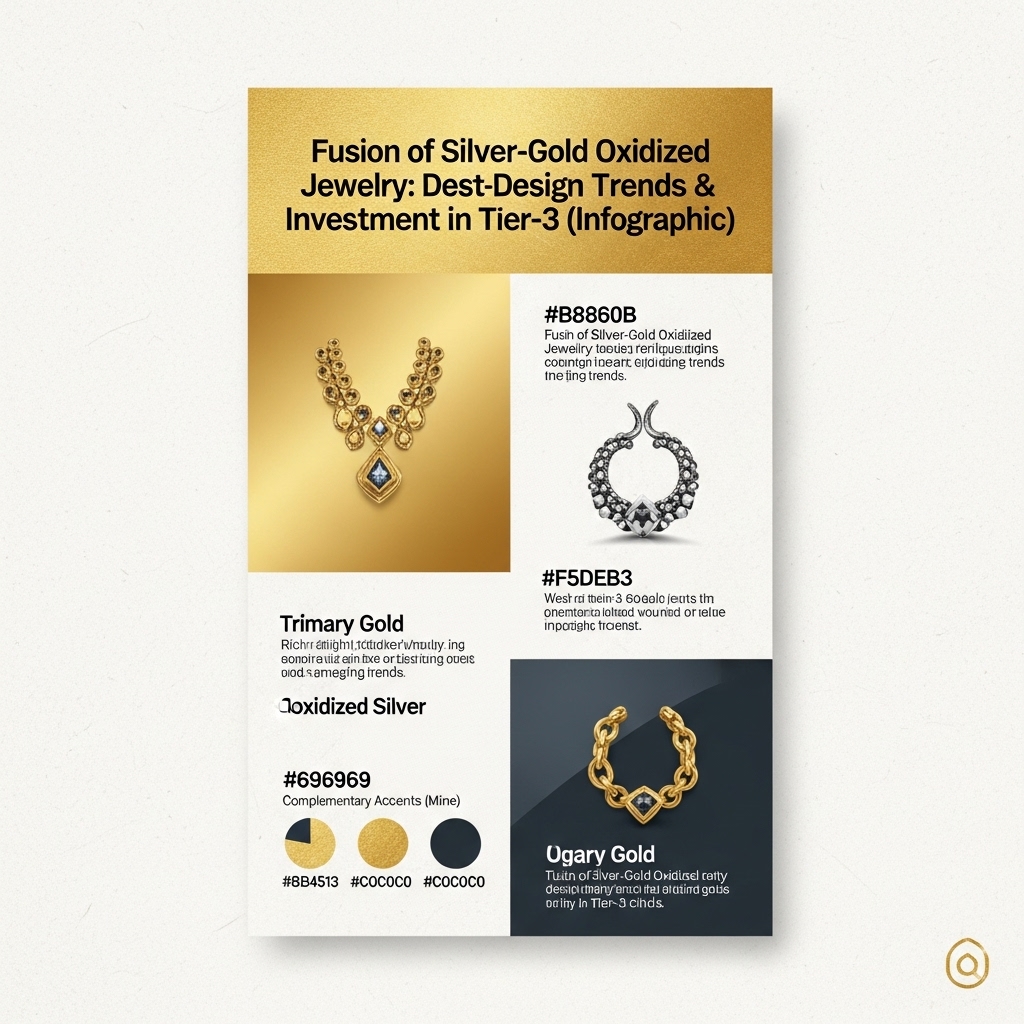Unearthing Investment Gold: The Surprising Impact of Tier-3 Jewelry Trends
In today’s dynamic economic landscape, gold continues to shine as a perennial safe haven and a powerful inflation hedge. As global uncertainties persist and central banks calibrate their policies, many astute investors are looking beyond traditional avenues, seeking granular insights into the market’s underlying drivers. While geopolitical shifts and macroeconomic indicators certainly dictate gold’s broader trajectory, understanding localized demand trends is equally crucial for discerning investors aiming to capitalize on emerging opportunities.
This post delves into an intriguing, yet often overlooked, aspect of gold consumption: the burgeoning trend of Fusion of Silver-Gold Oxidized Jewelry in India’s Tier-3 cities. Far from being just a fashion note, this unique design evolution holds significant implications for gold investors. We will explore how this specific aesthetic shift influences gold demand patterns, reflects evolving consumer preferences in a crucial market segment, and potentially shapes future investment opportunities.
For the forward-thinking gold investor, comprehending such micro-trends offers a competitive edge. It provides a unique lens into the expanding gold market in rapidly developing regions, highlighting new pockets of consumption and the changing nature of gold as an asset. By examining the commercial success and cultural resonance of this fusion jewelry, you’ll gain invaluable insights into how diversified demand, driven by innovation and local tastes, continues to underpin gold’s long-term value and investment appeal, offering potential for sustained growth and portfolio diversification.
Gold Market Analysis and Key Insights
The Fusion of Silver-Gold Oxidized Jewelry trend in Tier-3 cities, while seemingly reducing the gold footprint per piece, fundamentally leverages gold’s deeply ingrained investment appeal. For consumers in these regions, jewelry often transcends mere adornment, serving as a tangible asset and a preferred form of wealth preservation.
Gold’s Enduring Appeal in Tier-3 Cities
In Tier-3 cities, gold remains a cornerstone of financial security and cultural identity. It is widely perceived as a reliable hedge against inflation and economic instability, offering a secure store of value where formal financial instruments might be less accessible or trusted. Even with the rise of fusion designs, the inclusion of gold ensures the piece retains an inherent, transferable value, crucial for its adoption as a practical investment vehicle for families.
Current Gold Market Trends and Local Impact
Globally, gold prices have seen fluctuating but generally upward trajectories, driven by geopolitical tensions, interest rate changes, and currency devaluation concerns. In Tier-3 markets, this global volatility translates into a nuanced demand. While high pure gold jewelry remains a premium purchase, the fusion trend allows consumers to acquire aesthetically pleasing pieces that contain a precious metal component at a more accessible price point. This democratizes gold ownership, enabling smaller, incremental investments through jewelry purchases.
Investment Benefits and Considerations for Local Consumers
The primary benefits of gold jewelry as an investment include its high liquidity, tangibility, and cultural significance. It is easily transferable and universally accepted as value. However, consumers must consider factors like purity (caratage), which directly impacts resale value, and making charges, which are non-recoverable. Storage security is another vital consideration. For fusion pieces, understanding the precise gold content is paramount to accurately assess its investment component.
Expert Recommendations
For jewelers operating in Tier-3 cities, transparency regarding gold purity and weight in fusion jewelry is crucial to build trust. Offering hallmarked gold and clear buy-back policies will empower consumers. For buyers, it is recommended to purchase from reputable establishments, prioritize certified gold content, and view gold jewelry as a long-term asset rather than a speculative short-term investment, appreciating its role in wealth preservation and cultural heritage.

Gold Investment Strategies and Options
For consumers in Tier-3 cities, gold remains a cherished asset, not just for its aesthetic value in jewelry, but also as a traditional investment. Investment options vary significantly. Physical gold includes jewelry, coins, and bars. While jewelry carries sentimental value and is integral to the Fusion of Silver-Gold Oxidized Jewelry trend, it incurs making charges and purity concerns. Gold Exchange Traded Funds (ETFs) and Gold Mutual Funds offer exposure without physical storage hassles, providing liquidity and professional management but with expense ratios. Sovereign Gold Bonds (SGBs), issued by the government, are increasingly popular, offering semi-annual interest, no storage costs, and tax benefits on maturity, making them a secure and attractive long-term option. Digital gold platforms allow fractional investments, enhancing accessibility.
Risk assessment for gold typically positions it as a portfolio diversifier and a hedge against inflation and economic volatility. A common portfolio allocation strategy suggests allocating 5-15% of one’s investment portfolio to gold. Risks include price volatility, storage issues for physical gold, and counterparty risks for digital or paper forms.
Comparing methods, physical gold offers tangibility but lacks liquidity and incurs charges. ETFs/Mutual Funds provide ease of trade and purity assurance. SGBs stand out for their security, interest income, and tax efficiency, ideal for long-term holding. Market timing for gold is challenging; rather than short-term trading, a long-term strategic approach is advised. Investors should consider accumulating gold during market dips through systematic investments (rupee cost averaging) rather than attempting to perfectly time entry and exit points, aligning with its role as a stable asset.
Market Performance and Outlook
Historically, the ‘Fusion of Silver-Gold Oxidized Jewelry’ segment in Tier-3 cities was nascent, catering to a niche demand for affordable yet stylish alternatives to pure gold. Over the past five years, buoyed by rising disposable incomes, increased fashion consciousness, and social media influence, this market has witnessed significant expansion. Local artisans reported an average annual growth of 15-20% pre-pandemic, as consumers gravitated towards the aesthetic appeal of gold at a more accessible price point, coupled with the unique oxidized finish.
Currently, the market is robust. Tier-3 cities exhibit strong demand, particularly for festive and occasional wear, where the blend offers a distinct, modern look. The value proposition—combining gold’s prestige with silver’s affordability and oxidized silver’s trendiness—is a key driver. E-commerce platforms are further amplifying reach, allowing broader access to diverse designs.
Looking ahead, the future outlook is highly positive. We predict continued accelerated growth, potentially reaching a 25% CAGR over the next three years, driven by innovation in designs and increasing consumer acceptance. Economic factors heavily influence this segment. As global uncertainties and inflationary pressures push pure gold prices higher (currently hovering above record highs), the affordability and perceived value of silver-gold oxidized jewelry become even more compelling. Conversely, a strong USD can make gold relatively cheaper, but the inherent design trend and unique appeal of fusion jewelry in Tier-3 markets will likely maintain its growth trajectory independently of minor gold price corrections.
Frequently Asked Questions About Gold Investment
Is Fusion Oxidized Jewelry Considered a Gold Investment?
No, it’s primarily a fashion accessory. Its value lies in design and silver content, with minimal gold (often alloyed). It’s distinct from pure gold bullion or high-carat jewelry, and doesn’t track gold market prices as an investment.
How is the Intrinsic Value of Fusion Jewelry Assessed?
Its value is mainly based on silver weight and any minimal gold. Design and craftsmanship heavily contribute to its market price, meaning resale value is considerably lower than purchase price as it doesn’t primarily rely on metal weight.
Does This Jewelry Carry Standard Gold Hallmarks?
Standard gold hallmarks (e.g., BIS 916) are generally not applicable. Its gold content is too low or part of an alloy. Jewelers disclose composition, but it isn’t hallmarked as a pure gold product suitable for traditional investment.
What Are the Liquidity and Resale Considerations?
Liquidity is low. Resale value is significantly diminished because the aesthetic and design premium isn’t recoverable, and minimal gold content means low melt value. It’s bought for wear, not as a financial asset.
Why is This Trend Popular in Tier-3 Cities, and How Does It Affect Investment Appeal?
Its popularity in Tier-3 cities is due to affordability, unique aesthetics, and gold-like appearance without the pure gold price. For investors, this confirms its nature as a consumption item driven by fashion, not inherent material investment value.

Final Thoughts on Gold Investment
For gold investors, the rise of silver-gold oxidized jewelry in Tier-3 cities offers a compelling takeaway: gold’s market appeal is diversifying and expanding into novel consumption patterns. This trend highlights how innovative designs cater to evolving tastes, signaling robust, underlying demand for gold beyond traditional bullion or heavy pieces. It underscores gold’s adaptability and enduring cultural significance across varied demographics.
Our final recommendation is clear: gold remains a foundational investment. These fusion trends reinforce its long-term value, driven by a continually broadening consumer base. Smart investors should not only consider physical gold for portfolio stability but also appreciate how these nuanced market shifts solidify its enduring global demand. Stay informed and consider how these evolving trends shape your investment strategy.